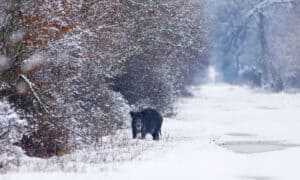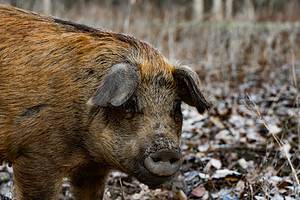Louisiana is home to lots of unique cultures, delicious foods, and exciting festivals. New Orleans alone has a population of 376,971 people from all over the world. Not only can you find unique culture and food but also lots of animals in the swamp and dense forests.
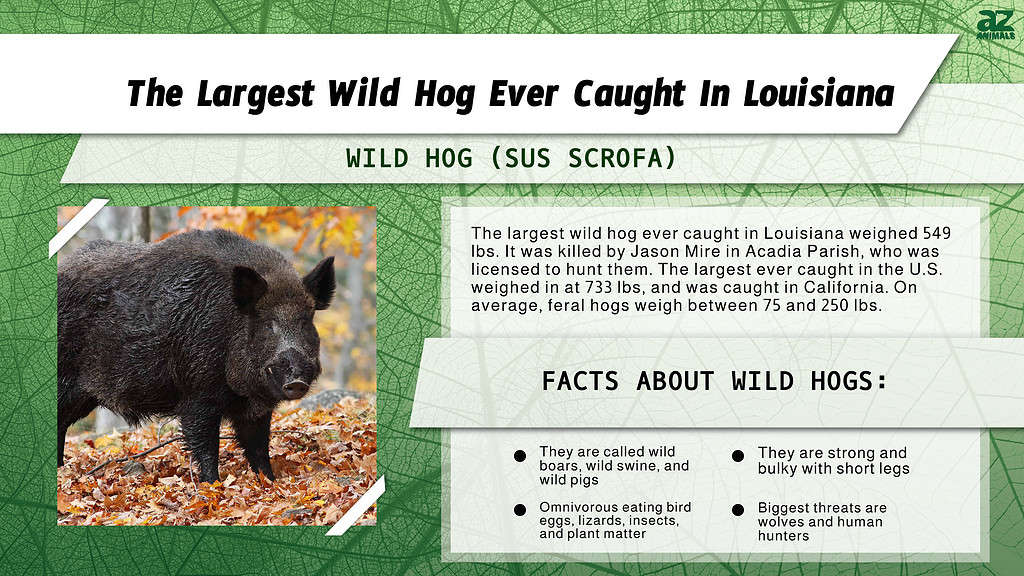
The state of Louisiana borders Texas, Arkansas, the Gulf of Mexico, and Mississippi. It is relatively flat with lots of lakes and rivers and moss-covered cypress trees. While visiting a lake or river in Louisiana, you have a chance to see different animals like American alligators, Louisiana black bears, and gray foxes. Although not native to Louisiana, feral wild hogs are in every parish in the state. They cause lots of problems and are considered invasive. Feral hogs are such a problem that with the right hunting license, you can hunt and kill them all year round.
These wild hogs get very big! Are you ready to find out just how large they grow? Keep reading to discover the largest wild hog ever caught in Louisiana.
About Wild Hogs
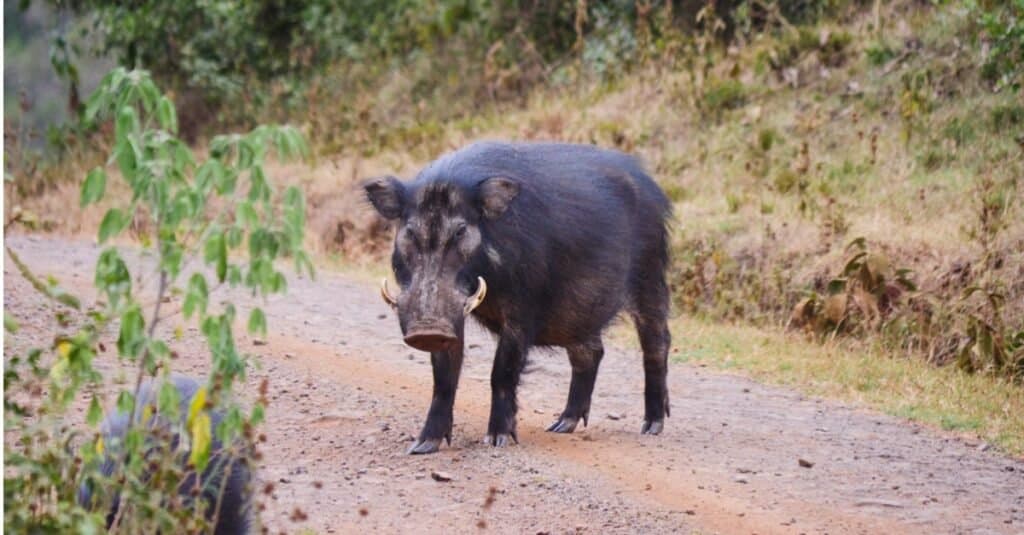
The size of a wild hog varies and depends on its environment.
©iStock.com/chingkai huang
Wild hogs have many names, including wild boars, wild swine, and wild pigs. Some people confuse the words pigs and hogs, especially because technically young swine are pigs, however, pigs typically refer to domestic pigs. They are native to Eurasia and North Africa but are common throughout the world. They were introduced to the Americas and Oceania, and are now invasive species in most places. There are 16 subspecies with unique characteristics.
Wild Hog: Appearance and Size
Unlike small pink pigs on farms, wild hogs are bulky with short legs. Despite their short legs, they are very fast and strong. They have short and robust trunks with underdeveloped hindquarters. On the back of their neck is a thick hump, which makes it hard for them to move their heads. Interestingly, there are many differences between male and female wild hogs. Male hogs are about 5–10% larger and 20–30% heavier than female boars. Their upper canines curve upwards and grow to the side. Male hogs also have a thick mane which becomes more prominent during fall and winter when temperatures drop.
But how large are these animals? The size of a wild hog varies and depends on its environment. For example, wild boars living in arid areas with little vegetation don’t grow very big. In Europe, male wild hogs are about 165–220 pounds, while females are 130–180 pounds. On average, male wild hogs in most of Europe are 30–31 inches tall in shoulder height and 59 inches long. Females are slightly smaller at 28 inches long and 55 inches wide. Some of the largest wild hogs have been recorded in Ussuriland and Manchuria and can weigh up to 770 pounds.
Wild Hog: Diet
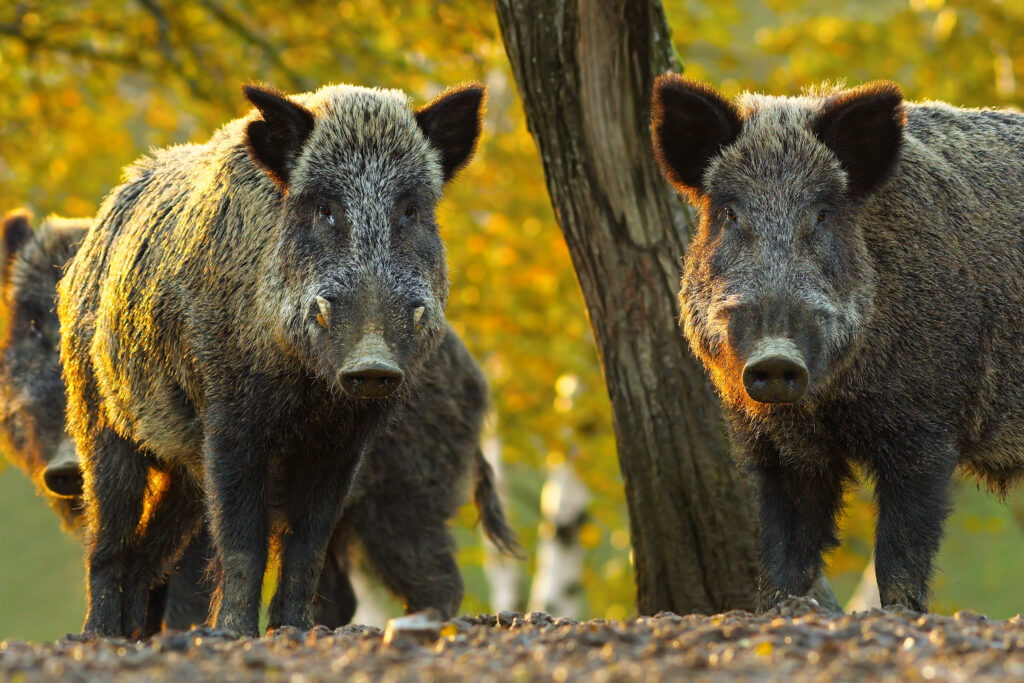
Wild hogs are omnivores who need a high-calorie diet to keep up with their lifestyle.
©iStock.com/taviphoto
Wild boars are omnivores that eat roots, nuts, berries, leaves, twigs, garbage, bird eggs, lizards, and insects. Large hogs need a high-calorie diet to keep up with their lifestyle. A 110-pound wild boar needs about 4,000–4,500 calories of food per day. However, their calorie intake increases during winter and pregnancy. Although they aren’t picky eaters, most of their food comes from underground, including bracken, willow herb, bulbs, and meadow herb roots. While not as common, large wild hogs consume small animals like young fawns, rabbits, and small birds. Wild hogs living near lakes and rivers also eat fish. Unlike humans, wild hogs can digest some poisonous plants without symptoms like wolf’s bane, anemone, and ferula.
Wild Hog: Predators
Wild hogs are aggressive and don’t have many predators. However, vulnerable piglets are hunted by medium-sized animals like Eurasian lynxes, jungle cats, snow leopards, brown bears, and yellow-throated martens. A wild hog’s biggest threat is wolves. In one year, a wolf can kill 50 to 80 wild hogs. The wild boar’s predator varies depending on the region. For example, the biggest threat to wild boar in Iran, China, the Caucasus, India, and the Russian Far East are leopards. However, in Komodo, Rinca, and Flores, the Komodo dragon is the wild hog’s main predator. Humans also hunt and kill wild hogs, especially where they are invasive. Wild hogs are strong and destroy millions of crops every year when rampaging through farms and land.
The Largest Wild Hog Ever Caught In Louisiana
The largest wild hog ever caught in Louisiana weighed an impressive 549 pounds. Jason Mire, on September 30th in Acadia Parish, shot and killed a large hog while it was munching on corn. He weighed it on crawfish scales using a forklift. He first noticed the large hog on a trail cam, and it was scaring away deer and other animals. Wild hog hunting is common in Louisiana. You can hunt for wild feral hogs as long as you have the right license and it’s in an area that allows hunting. Always double-check before engaging in a hunt.
Although 549 pounds is impressive, the largest wild hog ever caught weighed 733 pounds in California. However, rumors of a 1,000-pound wild hog have spread on the internet with a blurry photo. Eventually, experts examined the large wild hog and estimated it to be 800 pounds when alive. This big hog, along with its image, became known as Hogzilla.
Where Is Louisiana Found On A Map?
Louisiana is located in the southern part of the United States. It is bordered by Texas to the west, Mississippi to the east, Arkansas to the north, and the Gulf of Mexico to the south. Arcadia is located in the northern part of the state, between Monroe and Shreveport.
The photo featured at the top of this post is © iStock.com/JMrocek
Thank you for reading! Have some feedback for us? Contact the AZ Animals editorial team.



